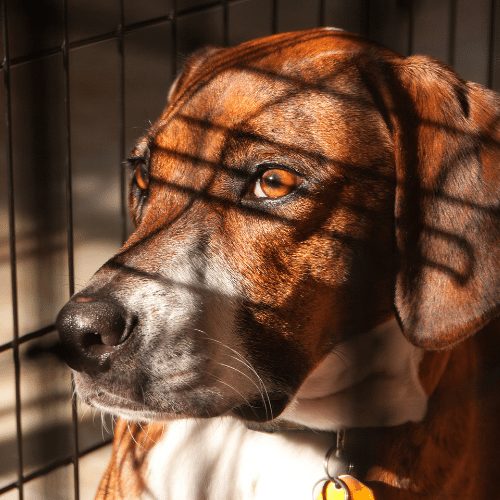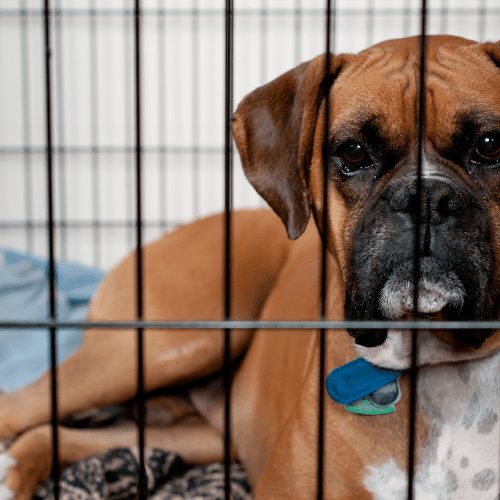Can Crate Training Cause Aggression?
March 30, 2021 2021-08-25 4:51Crate training can be an invaluable help for potty-training puppies and keeping them from tearing up your house when unsupervised. However, many owners hesitate to crate their dogs. They might be afraid that it could lead to behavioral problems.
Does crate training cause aggression? The quick answer is no – crating as a management tool will not make your dog aggressive. You don’t need to stop crating your dog because you fear it will make him aggressive.
However, you need to watch out to not create any boundary reactivity as you are crate training your dog. Let’s look in detail at how you can make the crate a place of comfort and rest for your dog.
Table of Contents

Why are some dogs aggressive in crates?
When a dog is in a crate, he is very restricted in how he can use his body language. He also cannot simply leave a situation in which he is uncomfortable. Unfortunately, many owners make the mistake to let others bother their dog while he is in a crate.
When your dog is crated, you should always watch out that:
- No other dogs approach the crate or try to sniff your dog through the crate
- No other dogs stare at your dog in his crate
- No kids taunt the dog
- Nobody sticks their fingers into the crate
- No other pets (such as cats) have access to the crate
If anyone can get close to the crate, the dog has no way to avoid any confrontation or threatening situation. The only way he has to defend himself is to become outright aggressive. This aggression that happens whenever dogs are restricted (also by e.g. fences) is also called boundary aggression.
Crate training done incorrectly can quickly lead to this boundary aggression – watch out that your dog is never in a situation in which others make him uncomfortable in a crate!

Should you crate aggressive dogs?
What happens if your dog is already aggressive and you wonder if you can use crate training to help him become better?
First of all, the crate is a management tool. That means that it is a way to help you adjust the dog’s environment in a way that lets him succeed faster in displaying good behavior. However, management tools do not change behaviors. They simply help owners and dogs deal with the current situation better.
Whether or not crate training is the right management tool for your aggressive dog will depend on the type of aggression he displays.
If your dog is aggressive towards children in your household, it is not a good solution to simply put him in an indestructible crate and hope for the best. Such a severe and potentially very dangerous problem always needs the attention of an in-person trainer. In addition, you might need to consider rehoming your dog.
On the other hand, if your dog is displaying aggression towards e.g. a cat in your household, you might be able to manage their interactions by crating the dog routinely and keeping him away from the cat.
Making the crate a place of comfort
It is crucial to make the crate a comfortable place for your dog. He should never feel punished when you have him go to his crate. Specifically, this means:
Never put your dog in his crate in anger
You should never “drag” your dog to his crate, even if you are frustrated with his behavior. He will associate the crate with your anger and feel very uncomfortable with it. The more negative feelings dogs link to their crate, the less of a peaceful place it becomes. You can actually make a dog very apprehensive against his crate by putting him in there when you are angry.
Make it a comfy den
Unless your dog is highly destructive, do not put him in a “naked” crate. You should provide blankets and thick bedding for him. Dogs are suckers for comfort: The more welcoming the crate is, the more likely your dog is to seek it out as a resting place. Many dogs start to enjoy their comfy crates so much that they go there to sleep even when the door is open!
Don’t use it to “cure” behavioral issues
Unfortunately, some dog trainers recommend to use crates to address behavioral issues in dogs. This can often backfire. A dog with separation anxiety could become worse if crated for example.
Crate training is a management option. It is never a blanket fix for every issue! Do not try to use crating your dog to change his behavior. This will not work – the only way his behavior is going to change is for the worse.

Make it fair for your dog
You need to make crate training fair for your dog. Some owners only crate their dog once in a while, but for many hours. This is not fair to the dog. In order to have your dog accept the crate as a safe and secure resting place, you need to give him the time he needs to get used to it. If you plan to crate your dog, introduce this concept early on to him (ideally when he is a small puppy). If you stick a 4 year old dog that has never been crated before in a kennel for 5 hours, chances are this might actually cause some aggression!
The Bottom Line
Crate training done right will not cause aggression. However, if you do not follow basic guidelines, your dog may develop boundary frustration. If kids, other dogs or other pets of the household can walk by the dog and taunt him, he is likely to start lashing out at everything in front of his crate. Don’t make the mistake to create such boundary aggression.
Instead make the crate a place of comfort and relaxation. Allow your dog plenty of time to get used to it and provide soft bedding so that he feels comfortable.
If your dog already is aggressive, crating alone will not change this. The best way to address aggression is to work with a qualified and experienced in-person trainer.

